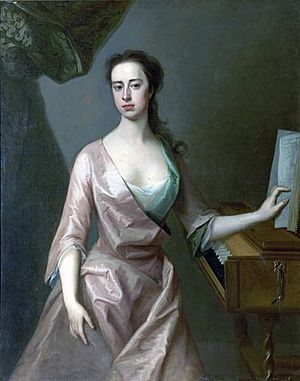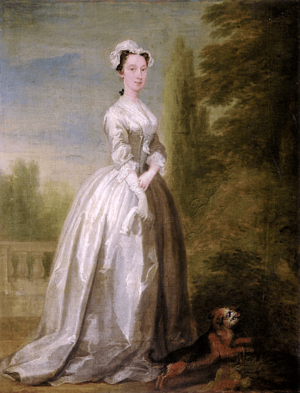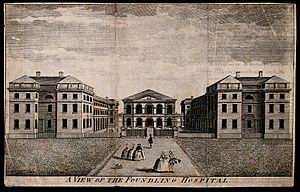Frances Byron, Baroness Byron facts for kids
Quick facts for kids
Frances Byron
|
|
|---|---|
| Baroness Byron Baronetess of Alderston |
|

Frances, painted by Michael Dahl in 1720
|
|
| Born | Frances Berkeley 1703 |
| Died | 13 September 1757 East Lothian |
| Spouse(s) | William Byron, 4th Baron Byron Sir Thomas Hay, 2nd Baronet of Alderston |
| Issue | Isabella Byron William Byron, 5th Baron Byron John Byron Reverend Richard Byron Charles Byron George Byron |
| Father | William Berkeley, 4th Baron Berkeley of Stratton |
| Mother | Frances Temple |
Frances, Baroness Byron (born Frances Berkeley; 1703 – 13 September 1757) was an important woman in 18th-century England. She was the daughter of William Berkeley, 4th Baron Berkeley of Stratton. Frances became the third wife of William Byron, 4th Baron Byron. She was also the great-grandmother of the famous poet Lord Byron.
Lady Byron was one of 21 influential women who signed a special request in 1729. This request, called a petition, helped create the Foundling Hospital. This hospital was a place that cared for abandoned children. Frances is also known because a famous artist, William Hogarth, painted her portrait. This painting has been shown at the Foundling Museum in London.
Contents
Frances's Life and Marriages
Frances Berkeley was born on April 5, 1703. She was the second of seven children. Her parents were William Berkeley, 4th Baron Berkeley of Stratton and Frances Temple. She was baptized a few days later, on April 9, in Westminster, London.
First Marriage to Lord Byron
On December 3, 1720, Frances Berkeley married William Byron, 4th Baron Byron. She was only 17 years old, and Lord Byron was 51. Her father arranged this marriage. He thought it was a good opportunity for her, even though there was a big age difference.
During her marriage to Lord Byron, Frances had six children:
- Isabella Byron (1721–1795)
- William Byron, 5th Baron Byron (1722–1798)
- Vice-Admiral John Byron (1723–1786)
- Reverend Richard Byron (1724–1811)
- Charles Byron (1726–1731)
- George Byron (1730–1789)
Frances is shown in an engraving by John Faber Jr.. This engraving was made after a portrait by Hogarth in 1736. Her first husband, Lord Byron, passed away on August 8, 1736. Through her second son, John Byron, Frances became the great-grandmother of the famous poet Lord Byron.
Second Marriage and Later Life
Four years after Lord Byron's death, Frances married again in 1740. Her second husband was Sir Thomas Hay, Bt.. They did not have any children together. Frances passed away before Sir Thomas.
Frances died on September 13, 1757, likely in East Lothian, Scotland. She was buried in her family's vault in Twickenham, England. In her will, she left all her property to her husband, Sir Thomas.
Helping the Foundling Hospital
In 1735, a man named Thomas Coram asked King George II for help. He wanted to build a hospital for abandoned children, called the Foundling Hospital. Frances was one of 21 important women who signed this petition. She signed it on April 14, 1730.
The support from these women was very new and forward-thinking. Their actions helped lead to two more petitions in 1737. Finally, in 1739, a special permission called a Royal Charter was granted. This allowed the hospital to be built. It was signed by 375 men, but the women who started it were not included.
Frances was likely influenced by her friend, Anne Newport, Baroness Torrington. Anne signed the petition on the same day. Frances's involvement also led to her son, William Byron, 5th Baron Byron, becoming involved with the Foundling Hospital in 1739. He was listed as an important governor, along with the artist Hogarth. However, some people believe William was not very supportive of the hospital's goals. He was known for selling off family property and paintings later in his life.
Frances in Hogarth's Painting
The artist William Hogarth painted a portrait of Lady Byron. We don't know all the details about how this painting came to be. However, Lord Byron, Frances's first husband, was a supporter of Hogarth's work. The portrait was painted six years after Frances signed the petition for the Foundling Museum. At the same time, Hogarth was painting Frances, new petitions were being organized for the hospital.
In a book about Hogarth's paintings, Frances is described in the portrait. She is "shown walking in a park, looking at the viewer with pale grey-blue eyes, pulling on a glove with her left hand." The painting also shows her "black and tan terrier" dog. The dog has a grey muzzle, which might suggest her husband was getting older.



